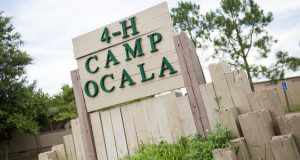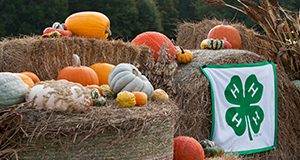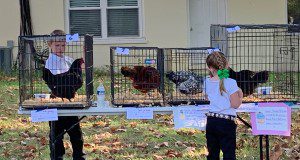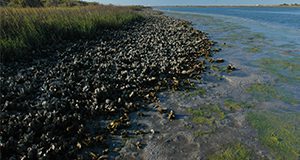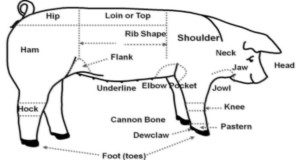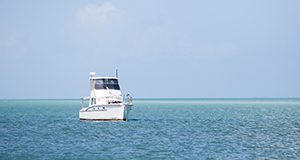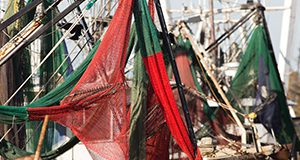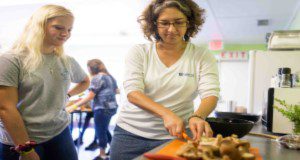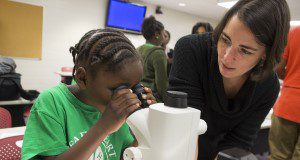Utilizing mindfulness as an evening reflection at residential camps has been developed as a tool for use at the end of the day during residential camps, though language may be modified for use at the end of classes or day camps. The four lessons in this new 7-page publication of the UF/IFAS Florida 4-H Youth Development Program, written by Heather Janney, were developed as a way for youth to reflect on their activities throughout the day. It is recommended to do only one lesson 15-20 minutes per day.
https://edis.ifas.ufl.edu/4h412
Category: 4-H Youth Development
Exemplary Youth Leadership Series: Encourage the Heart
This publication series is designed to outline strategies and experiences to expose youth to and engage them with leadership concepts. In this publication, students will try on aspects of the final practice of exemplary leaders: encouraging the heart. Two quick, low-cost activities are included for implementation with youth and adults working with youth. These activities are best suited for students ages 10–18. However, modifications are included for each of the activities to allow for different group sizes, ages, and abilities of the youth participating. This new 2-page publication of the UF/IFAS Department of Agricultural Education and Communication was written by Megan Stein.
https://edis.ifas.ufl.edu/wc377
Cooperative Unit Systems: 3. Swine Facilities
Facilities are one of the most important considerations for housing market swine projects in groups. This 5-page document discusses basic facilities requirements, weather protection, spacing requirements, penning arrangements, and fencing materials. Written by Alyssa Schortinghouse, and published by the UF/IFAS 4-H Youth Development Department, September 2020.
https://edis.ifas.ufl.edu/4h410
Understanding Extension for School-Based Agricultural Education #3: FFA and 4-H—A Comparison
Even though many recognize FFA and 4-H, there is still a big disconnect in understanding the similarities and differences between them. This 4-page document serves as an educational tool for school-based agricultural education and 4-H programs, and provides a background of the history, characteristics, and membership process of these long-standing organizations. Written by Debra Barry, Alyssa Shepherd, Jennifer Patton, and Stephen Gran, and published by the UF/IFAS Department of Agricultural Education and Communication, September 2020.
https://edis.ifas.ufl.edu/wc371
Cooperative Unit Systems: 1. Introduction and Raising Market Animals in a Group Setting
Traditionally, organizations such as 4-H have encouraged youth to participate in market animal projects as a way of increasing youth participation and introducing youth to production agriculture. As the demographics shift to a more urban clientele base for 4-H, there are new barriers of entry to market animal projects that were not seen in generations past. To address these barriers of entry, systems such as cooperative animal units have been set up. This 3-page document discusses components and limitations of cooperative animal units. Written by Alyssa Schortinghouse, and published by the UF/IFAS 4-H Youth Development Department, August 2020.
https://edis.ifas.ufl.edu/4h408
Cooperative Unit Systems: 2. Organizational Strategies
This 8-page document introduces the core requirements and organizational considerations for replicating a cooperative animal unit. Written by Alyssa Schortinghouse, and published by the UF/IFAS 4-H Youth Development Department, August 2020.
https://edis.ifas.ufl.edu/4h409
Florida 4-H Poultry Project Record Book
The Florida 4-H Poultry Project Record Book is designed as a tool for Florida 4-H members to keep records for their dual-purpose or show flocks. The Florida 4-H Poultry project’s purpose is to acquire an understanding of poultry production by preparing for, purchasing, breeding, caring for, and keeping records on one or more chickens or other poultry species. This 18-page major revision by Chris Decubellis is based on the original edition by L. W. Kalch and is a publication of the UF/IFAS Extension 4-H Youth Development Program.
https://edis.ifas.ufl.edu/4h038
Cetaceans 4th Grade Curriculum: Lesson 6: Cetacean Behaviors
This 4-page document is the sixth lesson in the Cetaceans 4th Grade Curriculum. It contains information that will help students learn about whale and dolphin behaviors. Written by Ruth Francis-Floyd and Maia Patterson McGuire, and published by the UF/IFAS Veterinary Medicine–Large Animal Clinical Sciences Department, June 2019.
http://edis.ifas.ufl.edu/vm231
Cetaceans 4th Grade Curriculum: Lesson 11: Introduction to Right Whales
This 10-page document is the eleventh lesson in the Cetaceans 4th Grade Curriculum. It contains information that will help students learn about North Atlantic right whale life history. Written by Ruth Francis-Floyd and Maia Patterson McGuire, and published by the UF/IFAS Veterinary Medicine–Large Animal Clinical Sciences Department, June 2019.
http://edis.ifas.ufl.edu/vm236
Raising a Market Show Hog
One of the most rewarding and educational 4-H projects is raising, finishing, and showing a market hog. Many younger 4-H’ers excitedly wait until the day when they can choose their first show pig. Parents and youth need to understand that while the hog project is an excellent opportunity, it requires a great deal of thought, preparation, time, and resources. The purpose of this new 7-page publication is to help parents and youth understand some of the commitments and preparations involved in raising a hog, as well as what to expect and what to do in order to successfully complete the project. Written by Chris DeCubellis and published by the UF/IFAS 4-H Youth Development Program.
https://edis.ifas.ufl.edu/4h407
Cetaceans 4th Grade Curriculum: Lesson 14: How Do Right Whales Communicate?
This 3-page document is the fourteenth lesson in the Cetaceans 4th Grade Curriculum. It contains information that will help students learn how baleen whales use sound to communicate, and how human-created noise in the ocean may affect their ability to do so. Written by Maia Patterson McGuire and Ruth Francis-Floyd, and published by the UF/IFAS Veterinary Medicine–Large Animal Clinical Sciences Department, June 2019.
http://edis.ifas.ufl.edu/vm239
Cetaceans 4th Grade Curriculum: Lesson 17: How Can We Reduce Threats to North Atlantic Right Whales?
This 13-page document is the seventeenth lesson in the Cetaceans 4th Grade Curriculum. It contains information that will help students learn about ways to minimize ship strikes and whale entanglements. Written by Maia Patterson McGuire and Ruth Francis-Floyd, and published by the UF/IFAS Veterinary Medicine–Large Animal Clinical Sciences Department, June 2019.
http://edis.ifas.ufl.edu/vm242
Cetaceans 4th Grade Curriculum: Lesson 10: Summarizing What We Know about Cetaceans
This 5-page document is the tenth lesson in the Cetaceans 4th Grade Curriculum. It contains information that will help students learn about different types of poetry and write poems to express what they know about whales and dolphins. Written by Maia Patterson McGuire and Ruth Francis-Floyd, and published by the UF/IFAS Veterinary Medicine–Large Animal Clinical Sciences Department, June 2019.
http://edis.ifas.ufl.edu/vm235
Cetaceans 4th Grade Curriculum: Lesson 18: Bringing It All Together
This 6-page document is the eighteenth lesson in the Cetaceans 4th Grade Curriculum. It contains information that will help students develop persuasive essays and corresponding presentations about North Atlantic right whales. Written by Maia Patterson McGuire and Ruth Francis-Floyd, and published by the UF/IFAS Veterinary Medicine–Large Animal Clinical Sciences Department, June 2019.
http://edis.ifas.ufl.edu/vm243
Cetaceans 4th Grade Curriculum: Lesson 15: Technology and North Atlantic Right Whales
This 6-page document is the fifteenth lesson in the Cetaceans 4th Grade Curriculum. It contains information and activities that will help students learn the ways that technology is being used to study North Atlantic right whales. Written by Maia Patterson McGuire and Ruth Francis-Floyd, and published by the UF/IFAS Veterinary Medicine–Large Animal Clinical Sciences Department, June 2019.
http://edis.ifas.ufl.edu/vm240
Cetaceans 4th Grade Curriculum: Lesson 5: Scientific Names: Understanding Where Those Funny Words Come from
This 7-page document is the fifth lesson in the Cetaceans 4th Grade Curriculum. It contains information and activities that will help students interpret the scientific names of certain whales and dolphins. Written by Maia Patterson McGuire and Ruth Francis-Floyd, and published by the UF/IFAS Veterinary Medicine–Large Animal Clinical Sciences Department, June 2019.
http://edis.ifas.ufl.edu/vm230
School-Based 4-H Programming Series: Positive Youth Development (PYD) and Social Emotional Learning (SEL): How They Complement Each Other
Positive Youth Development (PYD) promotes building life skills, leadership, and relationships, and Social Emotional Learning (SEL) promotes knowledge, responsibility, and caring. Just as 4-H uses PYD as a framework, so schools use SEL. A whole program approach with appropriate curriculum provide the skills necessary for youth to succeed. This new 5-page publication of the UF/IFAS 4-H Youth Development Program explores the complementary relationship between PYD and SEL in a school-based program setting. Written by Vanessa Spero-Swingle.
https://edis.ifas.ufl.edu/4h404
School-Based 4-H Programming Series: Setting Schools Up for Success
Success at school-based sites to form 4-H clubs and programs will depend on utilizing the developmental practices of positive youth development and incorporating a set of principles known as the Essential Elements. Youth benefit from feeling like they belong, mastering a skill, gaining independence, and exhibiting generosity. The 4-H club atmosphere provides a setting for youth to achieve lifelong skills as long as they are given the opportunity to learn them. This new 4-page publication of the UF/IFAS 4-H Youth and Development Program was written by Vanessa Spero-Swingle.
https://edis.ifas.ufl.edu/4h405
School-Based 4-H Programming Series: Designing Programs Based on Time Involvement
One of the biggest factors to consider when starting a school-based program is the amount of time and level of commitment that can be provided for the 4-H program at that site. This new 5-page document discusses the degree of commitment, intensity, and Positive Youth Development (PYD) impact of the program. The most PYD-intensive program will include a model for sustainability. Sustainable programs will ultimately survive and thrive without continual supervision and daily maintenance. Written by Vanessa Spero-Swingle and published by the UF/IFAS 4-H Youth Development Program.
https://edis.ifas.ufl.edu/4h406
Exploring Citizenship, Unit VII: My World
The 4-H Citizenship Project offers the opportunity to help 4-H members relate all of their 4-H projects and experiences to the world around them. The 4-H Citizenship manuals will serve as a guide for 4-H Citizenship experiences. To be truly meaningful to the real-life needs and interests of your group, the contribution of volunteer leaders is essential. Each person, neighborhood, and community has individual needs that you can help your group identify. This 14-page major revision of Unit VII covers the “My World” project. Written by John Rutledge, Joy C. Jordan, and Dale Pracht and published by the UF/IFAS Extension 4-H Youth Development program.
https://edis.ifas.ufl.edu/4h021
